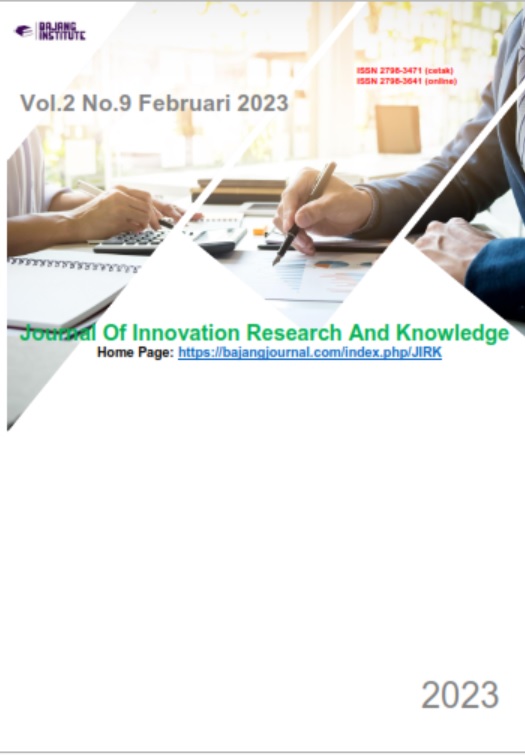STUDENTS’ PERCEPTION ON TEACHER’S NONVERBAL COMMUNICATION AT SMAN 1 SOPPENG
DOI:
https://doi.org/10.53625/jirk.v2i9.5013Keywords:
Non-Verbal Communication, Students’ Perception, EFL ClassroomAbstract
The study was aimed to explore students’ perceptions of their teacher’s non-verbal communication in teaching English and how nonverbal communications influences students' perception of English teachers' role and performance in the classroom. This study was a descriptive qualitative study conducted at SMAN 1 Soppeng. To achieve the objectives, the data were collected by Likert questionnaire, and interviewing. There were 61 students of eleventh grade in different classes as representative class in school, so the students chosen by purposive cluster sampling technique. The result of this research showed that interpretation to the way teacher’s nonverbal communication affected students’ perception and the way students perceive their teacher’s nonverbal communication is positive. All of the expected meaning behind the nonverbal communication could be understood by the students well. The entire teacher’s nonverbal communication where the researcher focused namely gestures, eye contact, and tone of voice functioned well. Students agreed that the use of nonverbal communication in the teaching and learning process works. Teacher’s nonverbal communication during teaching and learning process made them to be motivated to learn, focused their attention to the teacher’s explanations, and made them eagerly to speak or answer the questions, although there are some students feel nervous, aphetic in learning process, and feel afraid of being noticed.
References
A. Anggrawan, A. H. Yassi, C. Satria, B. Arafah and H. M. Makka, (2019) "Comparison of Online Learning Versus Face-to-Face Learning in English Grammar Learning," 2019 5th International Conference on Computing Engineering and Design (ICCED), 2019, pp. 1-4, doi: 10.1109/ICCED46541.2019.9161121.
Agarwal, S., & Jaya, SK. (2020). Students’ perception of Online Learning during Covid Pandemic. The Indian Journal of Pediatrics (July 2020), 87(7)-554. Retrieved from https://doi.org/10.1007/s12098-020-03327-7
Ahmad, F., & Aziz, J. (2009). Students’ perception of the teachers’ teaching of literature communicating and understanding through the eyes of the audience. European Journal of Social Sciences, 7(3), 17–26.
Chaplin, J.P. (2004). Dictionary of Psychology. Jakarta: Raja Grafindo Persada.
Edmondson, D. R. (2005). Likert scales: A history. CHARM, 12, 127–133.
Lunenburg, F. C. (2010). Louder than words: The hidden power of nonverbal communication in the workplace. International Journal of Scholarly Academic Intellectual Diversity, 12(1), 1–5.
Mark L, Knapp, Hall, Judith and Horgan, Terence G. (2013). Nonverbal communication in human interaction, 8th edn. Wadsworth, Florence, KY.
Mortazavi M. Meta-analysis of communication patterns in math learning journal article. Journal of Educational Technology. 2013; 9(2): 155-64. Persian.
Nordquist, R. (2018). What is nonverbal communication? ThoughtCo. Retrieved from https://www.thoughtco.com/what-is-nonverbal-communication-1691351
Pogue, L. L., & Ahyun, K. (2006). The Effect of Teacher Nonverbal Immediacyand Credibility on Student Motivation and Affective Learning. Communication Education, 55(3), 331–344.
Polit, D. F. Hungler (1999). Nursing Research: Principles and Methods. Lippincott.
Poyatas, Fernando (2002). The Nature, Morphology and Functions of Gestures, Manners and Postures as Documented by Creative Literature. Gesture, 2, 99-117.
Sugiyono. (2016). Metode Penelitian Kuantitatif Kualitatif, dan R&D (Qualitative Quantitative Research Methods, and R&D). Bandung: Alfabeta.
Simonic, I. (2016). The Influence of Teachers’ Physical Appearance and Other Nonverbal Communication Elements on Students’ Perceptions of the Teacher Role and Performance. University of Rijeka: English Language and Literature and Croation Language and Literature.















